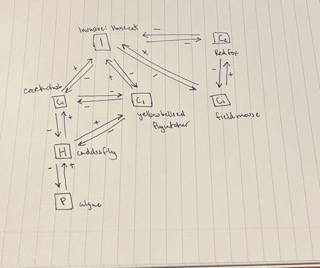
May 8, 2022
by nbtang
0 comments
Species Interaction Diagram


May 8, 2022
by nbtang
0 comments

May 8, 2022
by nbtang
0 comments
As I walked around my phenology spot for the final time this year I thought about the concept of phenology and how it has changed this spot. The slow dampening of colors as fall progressed shifted to the gray and white of winter. Now, spring has truly sprung and the color of the area has almost fully returned.

As I walked to my location I was greeted by a massive Pileated Woodpecker (Dryocopus Pileatus). I stopped to admire this specimen and felt like a fitting and climactic ending to this project. The water has returned to the area and so have the creek chubs. Much more water is moving through the brook and the island that was present in the fall has returned. Ferns and small shrubs are fully green while the larger deciduous trees in the area have not completely transitioned from buds to leaves.
Nature and culture are closely tied to my phenology location. Being a park, Centennial Woods is a place where people escape the hustle and bustle of everyday life. You can feel it the moment that you leave the earshot of the road. It provides a slice of nature in an urban area, and in my eyes a sanctuary for human activity—gaining cultural ecosystem services such as deeper feelings of connection to nature; it also provides a less-fragmented and more complete ecosystem for wildlife and birds. The place is also an area that is tied to the culture of stolen land and the proliferation of colonial ideologies. It is still an area that adheres to a Western view of nature being separate from humans, and furthermore is owned by a land grant school—cementing it as a place with a history of oppression against indigenous people.
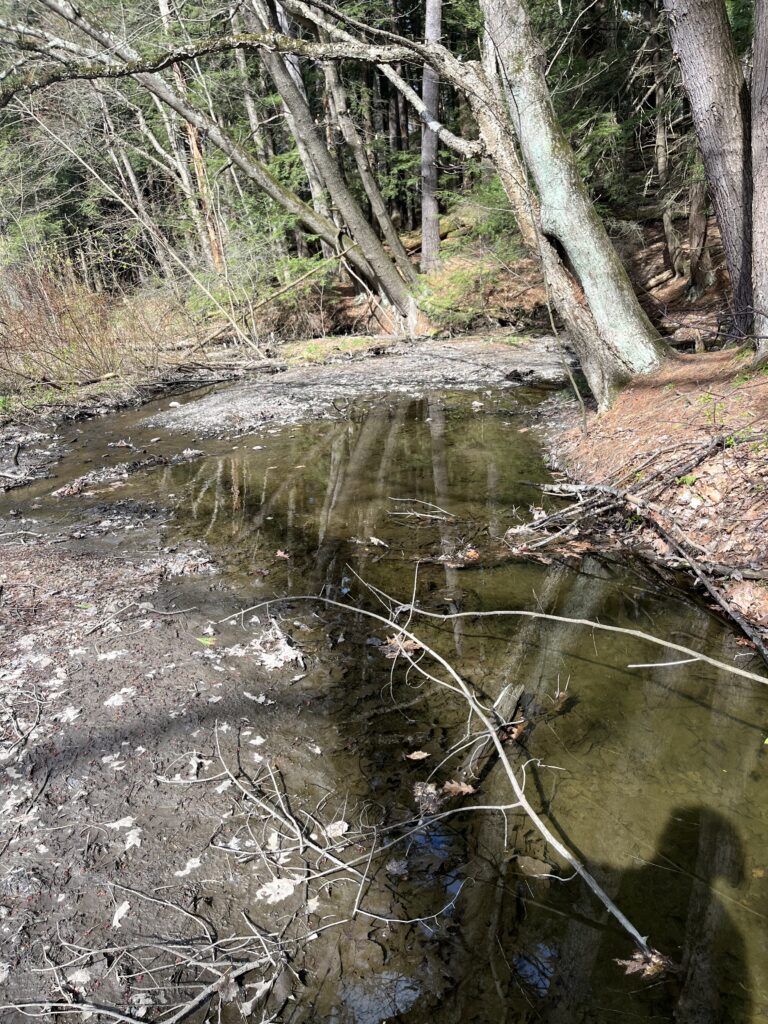
I would not call myself a part of my phenology location. I am a bystander, an observer, who is only taking part in the documentation of species in my place. I am not contributing to the competition that this ecosystem is undergoing. As phenological changes occur, I am not forced to adapt like the species of this location. So no, I am not a part of this location like a plant or bird species is, but as a young naturalist I have been able to observe and glean understanding from the processes and organisms that are a part of this ecosystem.
May 7, 2022
by nbtang
0 comments
The City Nature Challenge and the BioBlitz that it entailed made for an engaging time in Centennial Woods. I walked further than my phenology spot to the beaver pond—trying to tune my ears to the sounds of birds. After walking around the beaver pond I saw something slide into the water on the West side of the pond and saw a head waking before it dipped under the surface. Unless there are many muskrats in the area I am almost sure that this is the beaver (Castor Canadensis) that resides at the beaver pond. I was unable to capture the beaver on camera, but after walking to the Eastern edge of the pond saw the fresh evidence that what I saw was most likely the beaver.
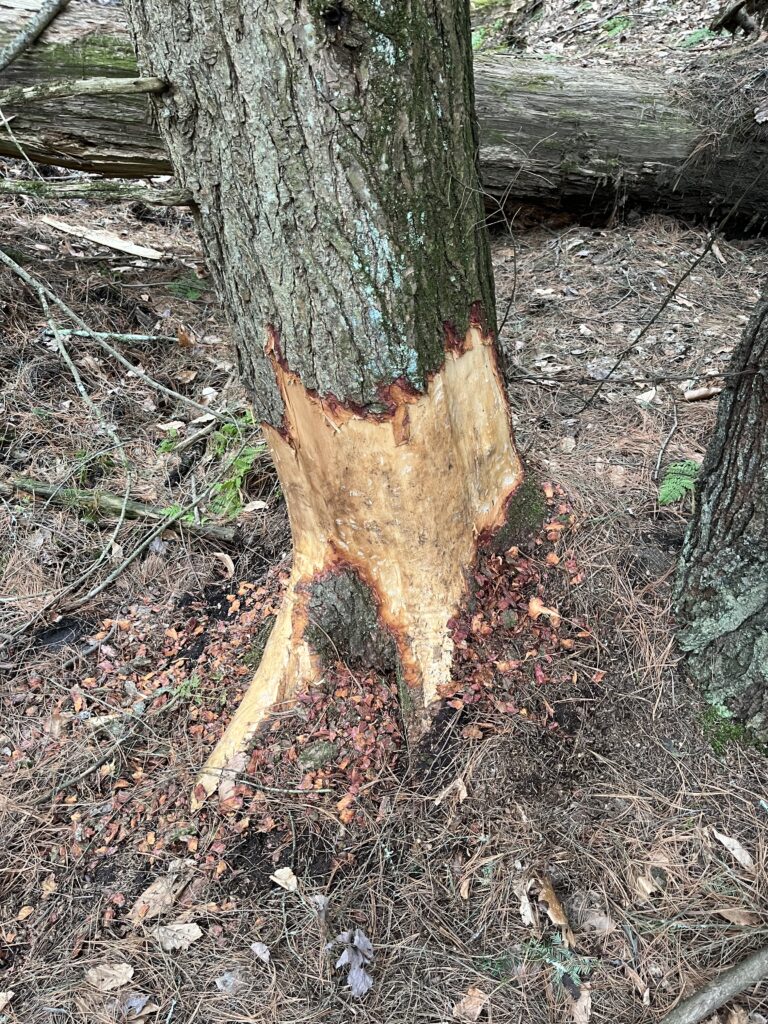
As I walked to my phenology spot I kept special attention on Centennial Brook. I turned over some rocks and found a caddisfly larva (Pycnopsyche sp.) crawling on the bottom of one of the rocks.

I also identified some creek chubs from the bank of the brook, but they were moving far too fast to capture a quality picture. It has been interesting to observe the returning of the creek chubs to my phenology spot and Centennial Brook as a whole. I was unable to catch quality pictures of some of the birds that I saw during the City Nature Challenge. The species that I was able to identify included crows, sparrows, and hairy woodpeckers.
Using iNaturalist to identify species was easy if I was able get a picture that I could use. When there was any uncertainty and there was too many suggestions for the species it was hard to differentiate between closely related/similar appearing species. From class Chris and Walt concluded that Garlic Mustard was the most identified species in the world. This really shows the ability of this species to adapt and the danger that it poses to native species.
I think that the biodiversity that occurs in other parts of the world that participated in the City Nature Challenge was very interesting to observe. Places like South Africa seem to have so many different species that are so different than what we have here in Vermont. It is odd to think that people take species that we view as exotic as everyday animals.
March 11, 2022
by nbtang
0 comments
The new area that I chose to study for my phenology blog was located on the banks of Otter Creek near the Middlebury Falls in Middlebury, VT.
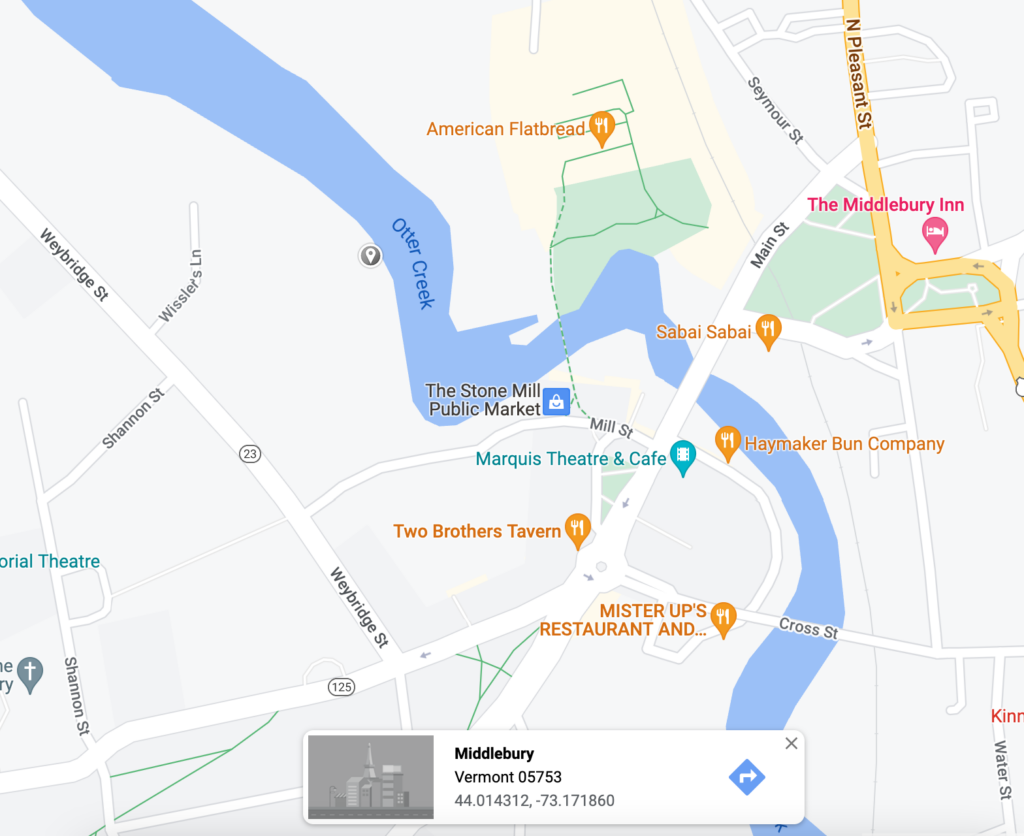
The creek was partially covered in ice still, but there were stretches of open water. The current was fast and the water was discolored and cold.

This area of the creek has no development on its banks directly. A quarter mile upstream from this spot there are businesses that line the Southern bank and a bridge that crosses the creek a few hundred meters below the falls. The trail that I took to reach this location seems to have been made by one of the residents on a hill a few hundred meters from the river bank. It does not seem that there has been any development since then, but based on the size of the trees in the area I would guess that the natural history of this area involved some clear-cutting in the past.
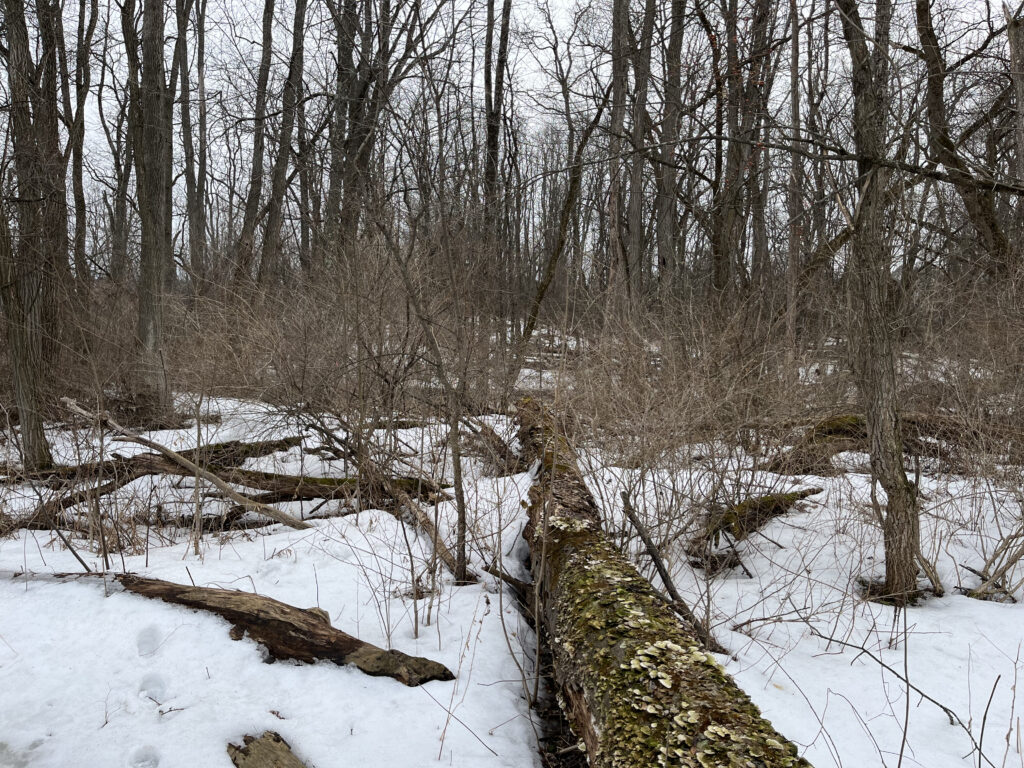
The birds that I was able to identify in this area were as follows: American Robin (turdus migratorius), American Crow (corvus), Tufted Titmouse (baeolophus bicolor), Canadian Goose (branta canadensis), and Northern Cardinal (cardinalis cardinalis). The cardinals that I saw were in what I assume was a mating pair—they stayed close to a nest and returned once they decided I was not a threat.
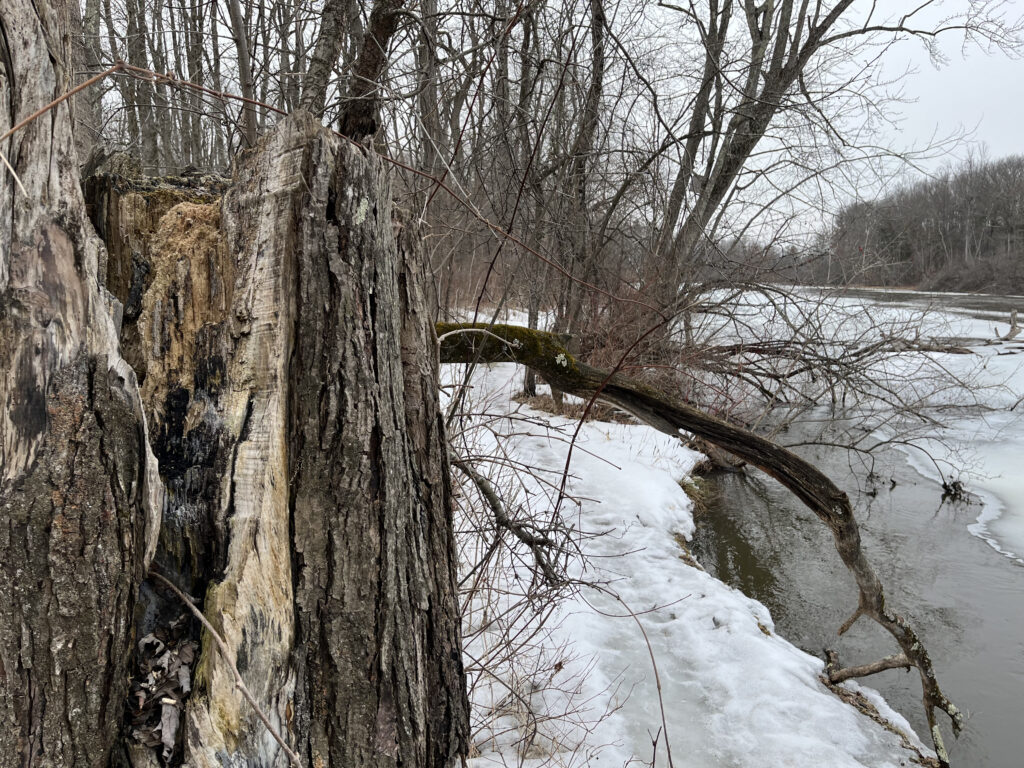
For the woody plant species in the area I was able to identify Basswood (tilia americana), Black Cherry (prunus serotina), Striped Maple (acer pensylvanicum), and Green Ash (fraxinus pennsylvanica). Something that surprised me was the absence of conifers in the area.
February 21, 2022
by nbtang
0 comments
This week I ventured further into Centennial Woods to observe the movement of animals in February. The day that I chose was not the best for tracking due to the high temperatures and rain. I was able to identify the tracks of many domestic dogs and their owners moving on the trails. When walking off-trail it was hard to discern tracks from falling snow. I saw a track that could have been snowshoe hare, but was unsure due to the frequency. A track that I found plenty of and was easily identifiable was the hoof-prints of whitetail deer.
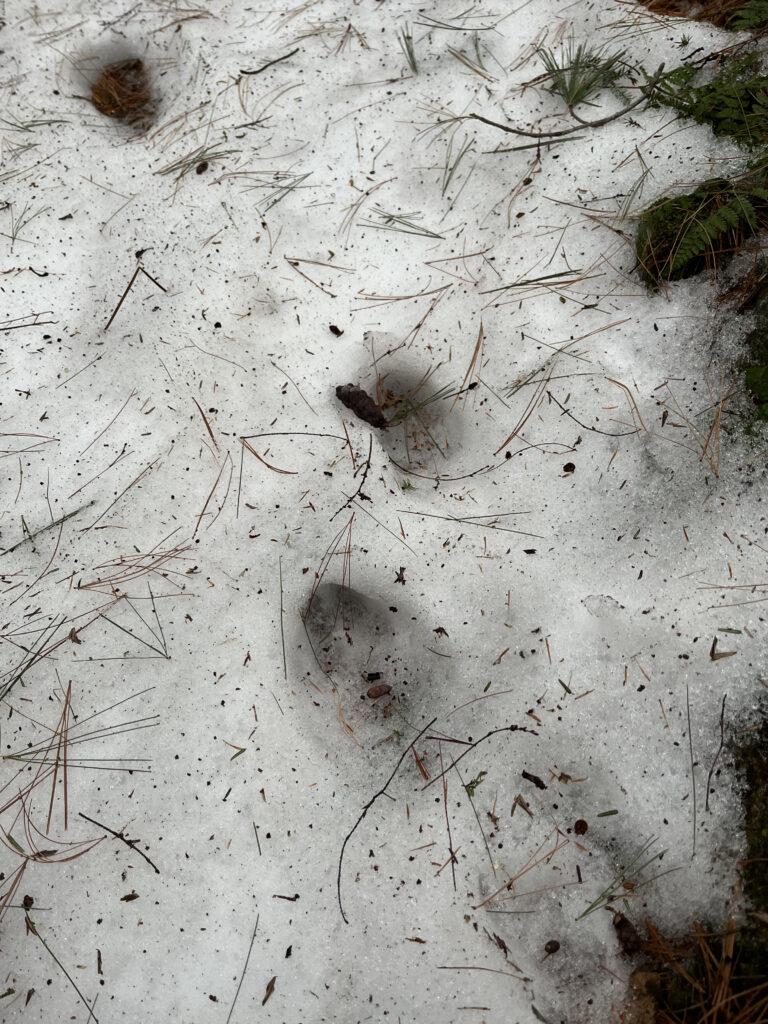
Evidence of animals feeding and scat was another thing that I was on the lookout for during my walk. While the only scat that I was able to find was that of domestic dog I was able to find the kill/feed site of some kind of predator. The tracks that lead up to the log were small and not defined, but the prey was a mouse.

Mouse remains on log ~150 yards from trail
I thought that this was an interesting occurrence because a part of the mouse was left. In winter, when calories are scarce I would expect the predator to eat all of the mouse. I think that the predator was a mammal due to the small tracks leading to the site and the absence of beak marks.
January 29, 2022
by nbtang
0 comments
My phenology location is covered in snow, the only thing that I was able to hear was a far off bird call—maybe a crow. I think that I picked one of the worse days for tracking due to the high winds and snow. I was able to discern the tracks of what I think is a cottontail rabbit making its way across the creek. I also noticed the potential tracks of a gray squirrel, leading from one tree to another, but it was hard to be sure due to the soft edges and blurriness of the tracks. All of this snow has clued me in that I am most likely not the only NR student using this location as my phenology spot. There was a cluster of boot tracks over my location leading every which way. One phenological change that I noticed was the lowering of the water level. My boot broke through over a section of usually running water and I found that it was completely dry. A few dead leaves hang from the oaks over the creek and and the shrubs that cover the North end of my spot are almost completely bare.

December 11, 2021
by nbtang
0 comments
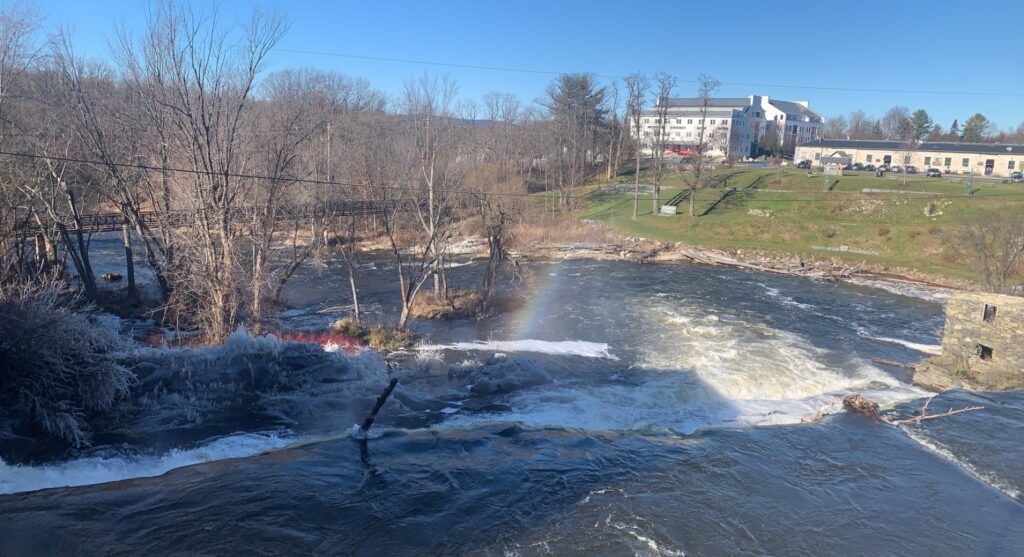
An area that I spent a lot of time in over Thanksgiving Break was the Marble Works District of downtown Middlebury. I love this location because of its natural beauty and close proximity to downtown Middlebury. I have seen this spot in almost all of the seasons, this transition to winter is one of the most beautiful. The spray and mist from the falls coats the rocks and trees with a shiny layer of ice. The water is much higher in the winter, spots where I stood and fished in the summer are in some places under a foot of cold, clear water. Water clarity is much better in the winter. Fish activity is low in the winter. On a summers’ night you can hear the splash and pop of smallmouth bass feeding on any insects unlucky enough to land in the water. The winter has driven most fish to deeper water to conserve energy. The lack of coniferous trees in this area makes for winters with little color in the forest. There are many more coniferous trees at my Centennial Woods location. It is a more wooded area and much farther away from human activity. I think that the phenological changes at the Otter Creek location are much more evident than those at Centennial Woods, but they are in a way more observable at Centennial Woods because of the smaller scale.
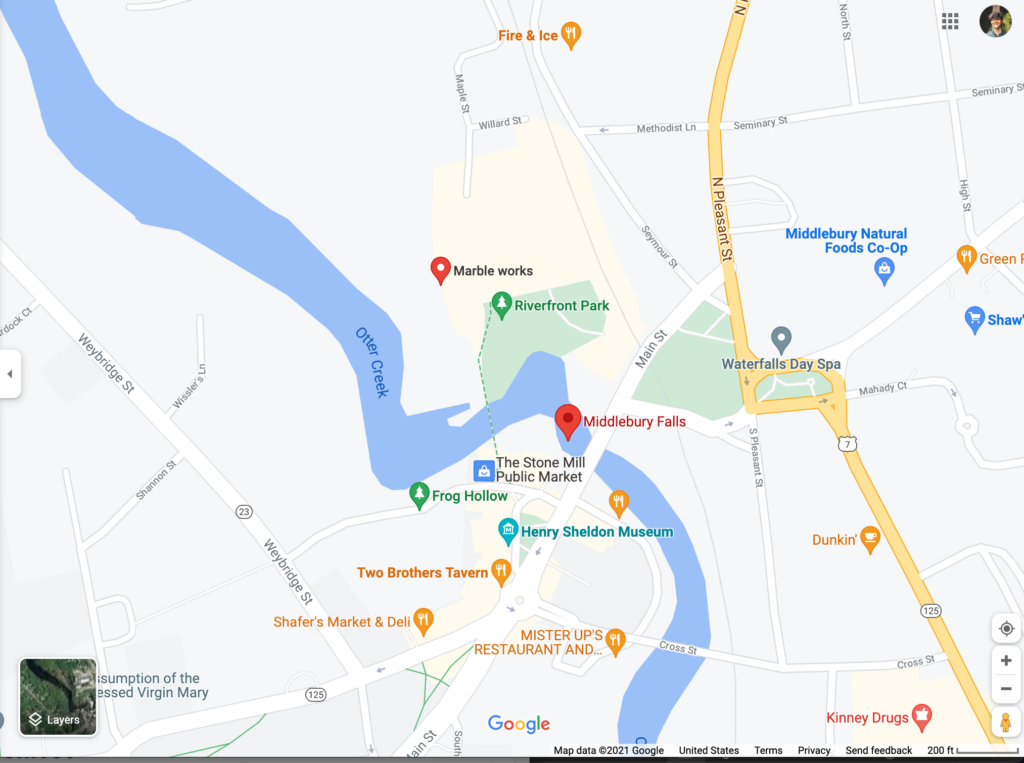
December 11, 2021
by nbtang
0 comments

There are some noticeable phenological changes that I observed when I went to my location this week. There is more of an O layer of pine needles and leaves. I visited soon after a rain event most of the island that I was standing on was covered in a few inches of water. This created some new channels around the main island and I could still see some creek chub (semotilus atromaculatus) activity in the deeper pools of the brook. The shrubs north of my spot have begun to lose their leaves. A small sugar maple is almost completely bare of leaves and a young hemlock is missing most of its needles. I assume the hemlock has some sort of sickness because it is an evergreen and should not be shedding as the seasons change. The water temp feels like it is still in the low 50’s to high 40’s—warmer than I expected at this time of year with this air temperature.
December 11, 2021
by nbtang
0 comments
Snow blankets most of my area and Centennial Brook has a thin slushy layer of ice forming on its surface. There is no longer any discernible movement from the creek chubs (semotilus atromaculatus) among the leaf litter lining the bottom of the brook. There was a surprising lack of tracks on the snow in my location. Aside from some large boot tracks and domestic dog paw prints cutting through my location I could not identify anything other than the signs of clumps of snow falling from trees. I even ventured deeper into the shrubs located to the North of my chosen location and found no tracks. The lack of birdsong was also something that I noted while sitting at my location.
Plant life is going through into its winter phase. All deciduous woody plants have lost leaves and the only green that remains comes from the hemlocks and white pines that encompass my location. I was surprised while walking in the shrubs to find some green ferns peeking through the snow. These ferns surviving lines up with the Naturally Curious classification that the leaves would persist in Decmeber. Another surprising thing that I noted was how green and healthy the lichen on a log looked. This led me to research the temperature tolerance levels of lichen. It can survive and even photosynthesize in subzero temperatures!
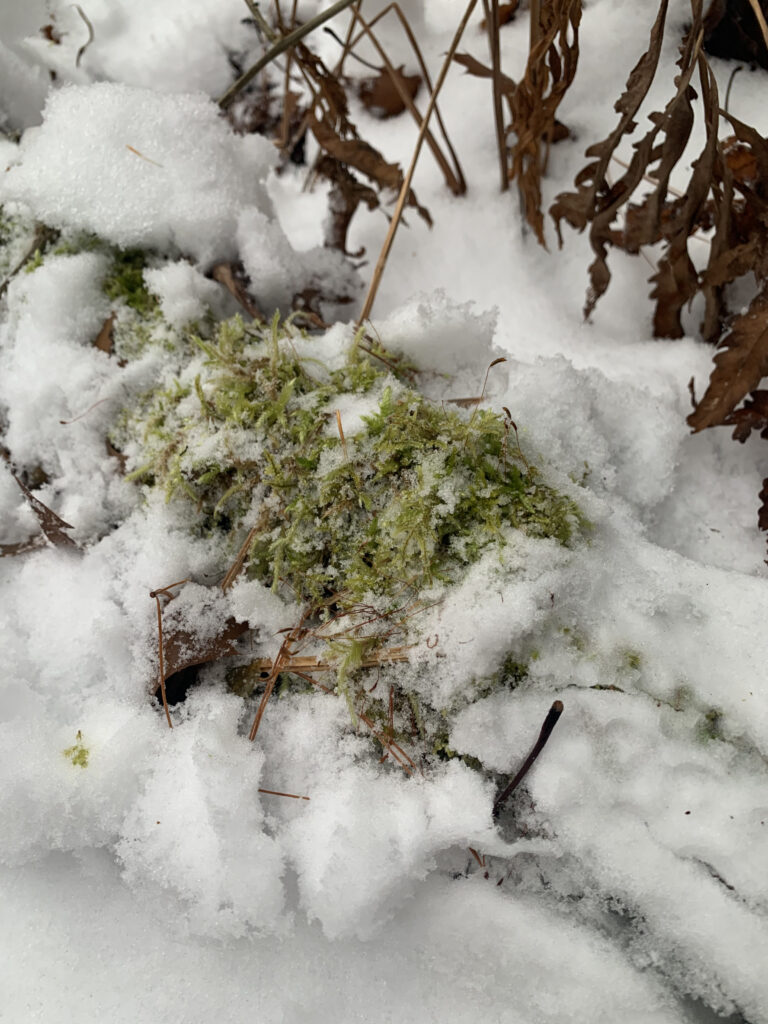
October 20, 2021
by nbtang
1 Comment
Local Phenology Location Blog Post 1
For my Phenological location I chose a spot in Centennial Woods that I have had my eye on since the first lab. It is about a 5 minute walk from the entrance of the woods and down a small hill to the creek bed. I chose this spot because I wanted an area where there I could observe the phenological changes that occur in small body of water. I am looking forward to see how the water level and habitat for aquatic organisms changes throughout the year. This spot also provides many different plant species to study. I found Eastern White Pine, Yellow Birch, Red Maple, Eastern Hemlock, and Buckthorn to name a few. I think that it will also be interesting to look at the bank composition and the erosion that I can already see develop throughout the year.


https://www.google.com/maps/d/u/0/edit?mid=1nrUb2O-LwCeLLG8WfnuWxtOtf6q8SxA1&usp=sharing